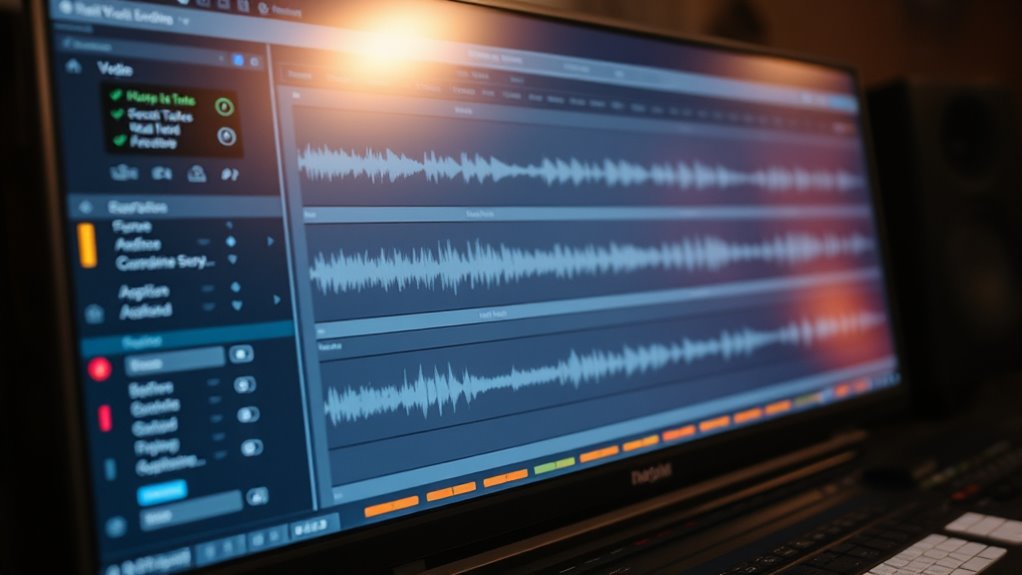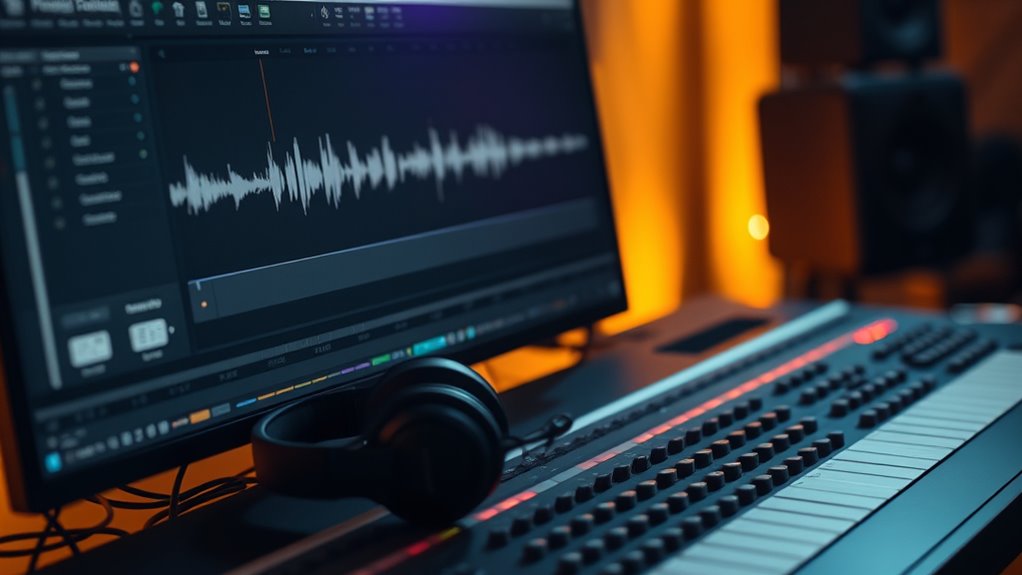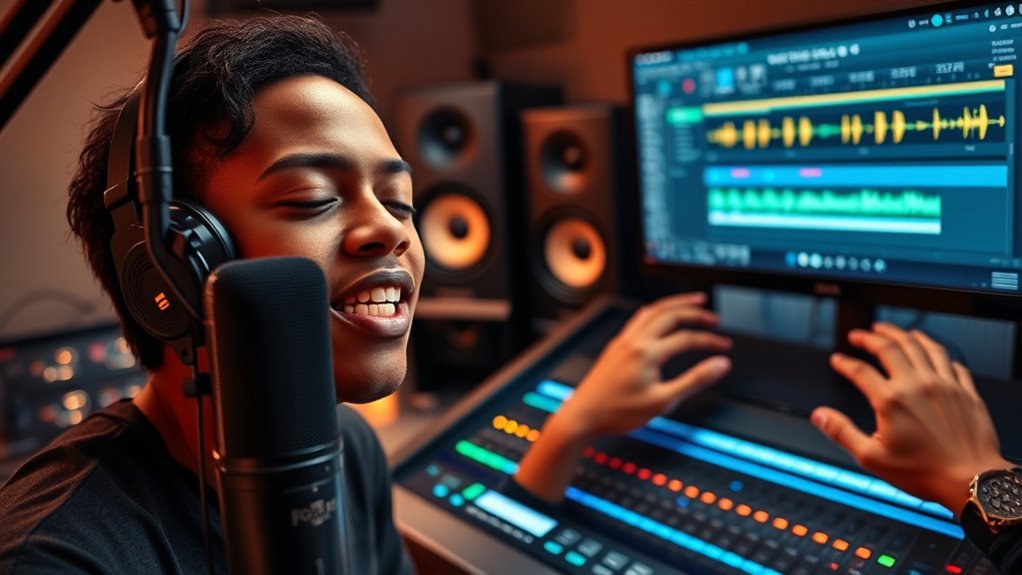To keep emotion while cutting vocal takes, focus on selecting the most expressive sections that capture the singer’s natural energy and nuances. Use precise editing tools to align takes seamlessly, avoiding abrupt jumps that break the flow. Apply crossfades and volume automation thoughtfully to preserve dynamic phrasing and emotional peaks. Maintain the original feel by listening critically and making subtle adjustments. If you want to master balancing technical precision with emotion, there’s more to discover below.
Key Takeaways
- Prioritize selecting takes with genuine emotional nuances and natural phrasing to preserve authenticity.
- Use precise editing tools like zoom waveform views and snap-to-grid for seamless clip alignment.
- Apply crossfades and volume automation to create smooth transitions without disrupting emotional flow.
- Maintain dynamic phrasing by fine-tuning volume and blending overlapping phrases for expressive continuity.
- Critically listen throughout, making subtle adjustments to ensure the performance remains lively and emotionally compelling.
Understanding the Importance of Emotional Continuity in Vocal Editing

Maintaining emotional continuity in vocal editing is essential because it preserves the singer’s authentic expression and the song’s overall feel. When you cut and compile different takes, it’s easy to disrupt the emotional flow if you’re not careful. Your goal should be to select sections where the singer’s performance remains consistent and genuine. Pay close attention to nuances like breath patterns, vocal inflections, and dynamic shifts, as these convey emotion. If you lose these subtle cues, the song risks sounding disconnected or robotic. By focusing on emotional continuity, you ensure the final performance feels natural and compelling, engaging listeners on a deeper level. Remember, every edit should serve the song’s emotional narrative, not just technical perfection. Additionally, understanding sound healing science can provide insights into how vibrations influence emotional states, which can be useful when aiming to maintain genuine emotional expression in vocal performances. Recognizing the emotional resonance of each phrase can help you make more informed editing choices that preserve the singer’s intent. Incorporating mindfulness techniques during the editing process can also help maintain focus and a sensitive ear for emotional detail. Cultivating an awareness of vibrational energy can further enhance your sensitivity to subtle emotional cues during editing.
Selecting the Most Expressive Takes for Your Project

How do you choose the most expressive takes that truly capture the singer’s emotion? First, listen carefully for genuine energy, focusing on subtle nuances like breath control, phrasing, and timing. Then, compare the emotional intensity across different takes to find the ones that resonate most with the song’s message. To help identify the best performances, look for:
Focus on genuine energy, subtle nuances, and emotional connection to find the most expressive vocal takes.
- Vocal inflections that convey raw emotion — the small shifts that make the lyrics feel alive
- Consistent energy and presence throughout the take, avoiding moments that feel detached or forced
- Authentic connection to the lyrics, ensuring the singer’s feelings shine through
- Paying attention to performance quality to select takes that truly reflect the singer’s expressive capabilities
Techniques for Seamless Transitions Between Vocal Clips

To create seamless passages between vocal clips, you should focus on crossfading to smooth out any abrupt changes. Ensuring your clips are properly aligned helps maintain timing and consistency. Engine tuning techniques can also be incorporated into your workflow to add warmth and depth to vocal takes, making transitions sound more natural. Additionally, paying attention to emotional expression can enhance the overall feel of the vocals, ensuring the performance remains heartfelt. Together, these techniques make your vocals sound polished and natural. Incorporating robust safety measures can also help prevent unintended artifacts or glitches during the editing process.
Crossfading for Smoothness
Crossfading is a crucial technique in vocal comping that helps create seamless changes between clips. It smooths out abrupt cuts, maintaining the vocal’s natural emotion and flow. When you apply a crossfade, you blend the tail of one clip with the start of the next, making the transition invisible. Visualize this as gently sliding from one vocal take to another, like turning a page softly. To do this effectively, you:
- Adjust the fade duration to match the tempo and energy.
- Position the crossfade where the clips naturally blend.
- Listen carefully to ensure the transition preserves emotion.
- Fade duration should be carefully calibrated to match the song’s rhythm and mood, ensuring that the transition feels both natural and expressive. Additionally, understanding the risks associated with poorly executed crossfades can help you avoid unnatural-sounding edits that disrupt the emotional continuity of the performance. Incorporating sound design principles can further enhance the seamlessness of your transitions and maintain listener engagement.
Aligning for Consistency
Achieving seamless shifts between vocal clips requires precise alignment to maintain the song’s natural flow. Start by zooming in on each clip’s waveforms to identify transients and peaks, ensuring they match across takes. Use snap-to-grid or manual nudging to position clips so that words and breaths line up smoothly. Pay attention to timing, avoiding abrupt jumps or gaps that disrupt the performance’s emotion. If necessary, adjust the clip’s start point slightly to align vowels, consonants, and breaths seamlessly. Accurate timing is essential for a cohesive vocal performance, as even small misalignments can distract the listener. Consistent alignment keeps the vocal track sounding cohesive, preserving emotional intensity. Remember, small timing tweaks can make a big difference in creating a polished, professional sound that feels natural and engaging throughout the song. Additionally, paying attention to audio quality can further enhance the overall seamlessness of vocal comping.
Using Crossfades and Automation to Preserve Vocal Feel

Using crossfades and automation helps you maintain the natural vibe of your vocals. Seamless crossfade changeover guarantees smoothness between clips, while dynamic volume automation preserves expressiveness. Together, these techniques keep your vocal feel intact and engaging throughout the mix. Incorporating proper paint sprayer techniques ensures a clean and professional finish in your projects. Additionally, understanding sound recording techniques and equipment can significantly enhance the quality of your vocal captures, making your automation and crossfades more effective. Being aware of Bitcoin IRA options can also provide insights into diversified investment strategies that support your financial goals.
Seamless Crossfade Transitions
Ever wondered how to make vocal shifts sound completely natural and smooth? Seamless crossfade *handovers* are your secret. They help blend takes without abrupt jumps, maintaining the song’s emotional flow. To achieve this, you’ll focus on precise timing and subtle automation. Imagine:
- Gradually fading out one take while fading in the next, like a gentle tide washing over the shore
- Fine-tuning automation curves to match the vocal’s natural dynamics
- Adjusting fade lengths to avoid noticeable seams, keeping the vocal feel intact
Dynamic Volume Automation
To maintain the vocal’s natural emotion and clarity during editing, dynamic volume automation becomes essential. By carefully adjusting volume levels with automation, you can smooth out abrupt changes and prevent noticeable jumps that disrupt the vocal flow. Use subtle crossfades between takes to create seamless progressions, preserving the vocal’s expressive nuances. Automate volume to emphasize emotional peaks and soften quieter moments, ensuring the performance feels alive and authentic. Keep an eye on the waveform to identify where natural dynamics may need enhancement. Remember, small, intentional adjustments make a big difference in maintaining the vocal feel. Combining crossfades with precise volume automation helps you craft a cohesive, emotionally compelling vocal track without sacrificing its original vibe.
Preserving Vocal Expressiveness
Maintaining the natural expressiveness of a vocal performance requires careful handling of editing techniques like crossfades and automation. To keep the emotion intact, focus on subtle adjustments that preserve the singer’s intent. Use crossfades to smoothly pass between takes, avoiding abrupt cuts that can disrupt the vibe. Automation helps you fine-tune volume and dynamics, highlighting emotional peaks and softening quieter moments. Imagine:
- Blending overlapping phrases seamlessly for a cohesive feel
- Enhancing gentle vibrato or subtle inflections with precise volume tweaks
- Preserving expressive pauses that add emotional weight
These techniques guarantee your edits serve the performance, not overshadow it, allowing the vocal feel to shine through even after multiple takes. The goal is to keep the performance’s soul alive in your final mix.
Editing With Sensitivity: Maintaining Natural Dynamics and Phrasing

When editing vocal comping, it’s essential to preserve the singer’s natural dynamics and phrasing to keep the performance authentic. Focus on subtle adjustments, avoiding abrupt volume changes or unnatural timing that can disrupt the flow. Listen carefully to the original take, and only make edits where necessary, such as smoothing out minor inconsistencies without removing the performance’s emotional nuance. Use fades and crossfades thoughtfully to maintain natural *progressions* between clips. Keep an ear on phrasing, *guaranteeing* that breaths, accents, and timing stay true to the singer’s intent. Your goal is to enhance clarity without sacrificing the performance’s organic feel. Gentle editing preserves the singer’s expressiveness and ensures the final result resonates with the original emotion.
Final Checks: Ensuring the Vocal Performance Feels Authentic

Before finalizing your vocal mix, it’s essential to listen critically and assess whether the performance still feels genuine. Trust your ears to detect any signs of artificiality or lost emotion. Focus on these key areas:
- The natural flow of phrases, ensuring they haven’t been overly manipulated or stiffened.
- The emotional intensity, confirming it remains compelling and relatable.
- The overall vibe, making sure the vocal still connects with the song’s mood and message.
Imagine you’re stepping back and hearing the performance as a listener. If something sounds off or disconnected, make subtle adjustments or revisit earlier steps. This final check ensures your vocals retain authenticity, keeping the emotion alive and resonating with your audience.
Frequently Asked Questions
How Can I Identify Subtle Emotional Cues in Vocal Takes?
To spot subtle emotional cues in vocal takes, listen closely and pay attention to small nuances in tone, pitch, and timing. Trust your instincts and focus on moments where the singer’s voice naturally conveys feeling, even if it’s slight. Use your ears to identify shifts or variations that reveal genuine emotion. By actively analyzing these details, you can select takes that preserve the singer’s authentic expression.
What Tools Help Measure Vocal Emotional Consistency During Editing?
To measure vocal emotional consistency during editing, you can use tools like pitch and vibrato analysis software, which highlight variations in tone and expression. Spectral analyzers help you see the energy and frequency changes that reflect emotion. Additionally, listening carefully and comparing takes side-by-side permits you to identify subtle shifts. Combining these tools with your ears guarantees you maintain the genuine emotion in your vocals while editing efficiently.
How Do I Prevent Technical Edits From Disrupting Vocal Tone?
Like a skilled gardener pruning a delicate plant, you want to trim your vocals without harming their essence. To prevent technical edits from disrupting tone, listen carefully to the emotion behind each take and make subtle adjustments. Use fades and crossfades smoothly, and consider employing pitch correction sparingly. Keep the natural dynamics intact, and always check your edits by listening in context, ensuring the vocal’s soul remains vibrant and authentic.
What Are Common Mistakes That Weaken Vocal Emotional Impact?
When addressing vocal performances, you often weaken emotional impact by over-editing or removing genuine nuances. You might cut too precisely, losing natural dynamics and breathes that convey emotion. Rushing edits or applying too many effects can also strip away authenticity. To keep the feeling alive, you should focus on maintaining expressive moments, make subtle adjustments, and listen critically to ensure your edits serve the song’s emotional core.
How Can I Train My Ears to Detect Emotional Variations Accurately?
Think of your ears as a finely tuned radio, picking up subtle emotional signals. To train them, listen actively to a wide variety of vocals and focus on nuances like breath, pitch, and timing. Practice comparing takes side-by-side, noting what feels emotionally genuine. Over time, you’ll sharpen your ability to detect these delicate shifts, ensuring you preserve the raw emotion that makes a vocal performance compelling.
Conclusion
By balancing boldness with subtlety, you bring your vocals to life without losing their natural nuance. Keep your cuts clean, your shifts tender, and your automation attentive. When you approach editing with empathy and effort, you preserve the passion, power, and personality of every take. Remember, seamless singing stories stem from sensitive slicing and thoughtful touches—turning raw recordings into resonant, real performances that truly resonate.









